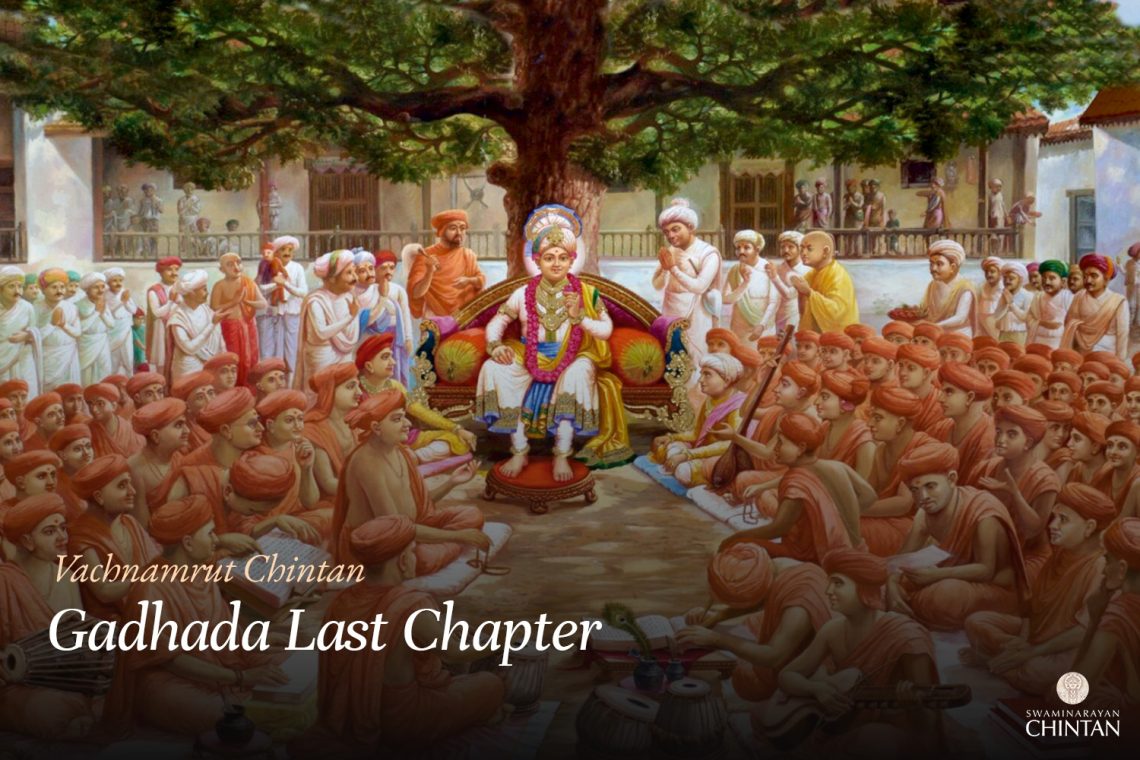Central Insights:
- The unity in multiplicity and divinity of the murti.
Key Points:
- Although appearing distinct, the murti in Akshardham is the same as the present murti. Meditation should be performed with this firm conviction.
- The more one detaches from other attachments and becomes attached to the murti, the quicker one experiences its reality.
Explanation:
In this Vachanamrut, Shreeji Maharaj first had the saints sing devotional hymns of loving devotion (prembhakti). He then spoke about a topic that greatly benefits those who practice meditation. Maharaj explained that Akshardham, Bhagwan’s abode, is of the nature of Brahm—a limitless ocean of radiant light, akin to the brilliance of countless moons, suns, and fires combined. Within this divine light resides the form of Purushottam Bhagwan, who assumes incarnations from this form.
Who is this Bhagwan? He is beyond Akshar, the cause of all causes, and is the supreme object of worship for the Akshar Muktas. This same Bhagwan has manifest as Shreeji Maharaj and is present before us.
When a meditator’s vision becomes fully detached from all other forms and worldly objects, and is entirely absorbed in Bhagwan’s form, they perceive no difference between the murti present before their eyes and the murti in Akshardham. As one becomes deeply attached to the murti, the radiant and majestic form of the murti in Akshardham and the seemingly simpler, human-like form of Maharaj manifest on earth, appear identical. Even a consecrated murti of Maharaj, made of metal or stone following scriptural guidelines, is indistinguishable from these other forms to the meditator. The murti’s forms, states, and radiance appear exactly the same—without even the slightest variation, not even the thickness of a hair. Thus, the meditator experiences complete oneness in these forms.
The human-like qualities Maharaj exhibits in His manifest form are merely a result of His independent will. Similarly, any reduction in His radiance and majesty is also by His own choice. When one detaches from worldly attachments and becomes entirely attached to Bhagwan, these coverings are removed, and the true nature of Bhagwan’s form becomes evident. Alternatively, one can perceive this reality in samadhi (spiritual trance). Without such attachment or samadhi, this understanding remains inaccessible. Therefore, we, who have a worldly perspective, must place unwavering faith in Maharaj’s words and practice meditation on His murti. Maharaj indicates that the murti radiant with light and majesty is the same as the form of Maharaj seen here. This must be firmly believed.
Maharaj then discussed the process of meditation. When a devotee meditates on Bhagwan in reverse progression—from the image reflected in the pupil of the eye to the murti envisioned within the body—the murti appears in varying forms. It may appear small in the pupil, large in the throat region, thumb-sized in the intelligence or the soul, and ultimately, as a radiant, human-like murti surrounded by immense light. These variations are due to differences in location.
Maharaj illustrated this with the analogy of a shadow. Although the body remains the same, its shadow appears small or large depending on the time of day. Similarly, a single face appears different during emotions such as anger, joy, or astonishment, yet it is the same face. In the same way, a meditator may perceive Bhagwan’s murti differently or, due to its human-like appearance, may not see its divine radiance and majesty. However, the murti in Akshardham and the manifest form of Maharaj before us are identical, without even the slightest difference. Devotees must meditate and remember Bhagwan’s murti with this firm conviction and determination, until they achieve liberation. This is the central message of this Vachanamrut.
Glossary
| Murti – Divine form of God Refers to Bhagwan’s physical or imagined divine form, which provides joy and spiritual connection during contemplation. |
| Akshardham – The eternal supreme abode of Bhagwan Swaminarayan The divine realm where Bhagwan Swaminarayan resides along with Akshar Muktas (Divine Liberated Souls) |
| Akshar – Eternal Entity The highest spiritual reality beyond material existence, often associated with Bhagwan’ Swaminarayans divine abode. |
| Purushottam – Supreme God A term used to refer to the highest, most perfect form of God, often associated with Bhagwan Swaminarayan. |
| Prembhakti – Loving devotion |
| Meditation – Focused spiritual practice |
| Samadhi – Deep meditative state A state of deep, focused meditation, where the body remains unconscious and the mind is absorbed in God and divine experience. |

